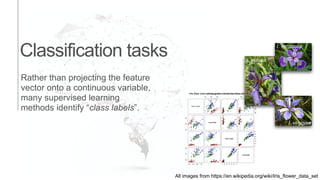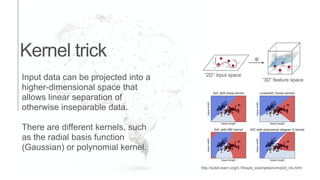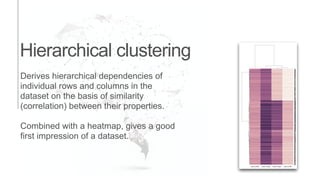Computational decision making
- 1. Computational decision making Dr. Boris Adryan @BorisAdryan
- 2. What I aim to provide ✓basic vocabulary for ✓fundamental concepts of computational decision making ✓phenomenological introduction to machine learning methods ✓a rough idea when and how to use these methods
- 3. What this presentation isn’t x hands-on tutorial x thorough summary x comprehensive guide x technical deep dive x statistics course
- 4. Is this artificial intelligence? word = input(‘Enter a word:’) for key in British_dictionary.iteritems(): if key.startswith(word): print(‘This is a British word.’)
- 5. Is this machine learning? temperature = float(input('What is the temperature?')) if temperature >= 1.0: print('Wear shorts.') else: print('Wear long underwear.’)
- 6. Definition Rule-based decision making on the basis of numeric thresholds or string patterns etc is not machine learning. And most definitely it is not artificial intelligence.
- 7. But what if… …the threshold is inferred at run time? “Write a software that says how close to Euston you can move if you can afford to spend £650k.” 450 550 650 750 850 950 1050 0 3 6 9 12 Average property price Northern Line, number of stops from Euston table = input_table(‘cost at station’) print(where_x_yields_a_low_enough_y)
- 8. Linear regression is probably the most simple “machine learning” method. Average property price Northern Line, number of stops from Euston It is an example of supervised learning, because we teach the computer the relation between an input variable (“feature”) and an output variable (“label”). 450 550 650 750 850 950 1050 0 3 6 9 12 y = m . x + b
- 9. Linear regression can become arbitrarily complicated. The difference between curve fitting in statistics and machine learning is mostly semantics. f(number of stops to Euston, square footage, bedrooms, bathrooms, …) price many features Euston High Barnet small large price
- 10. Classification tasks I. setosa I. virginica I. versicolor All images from https://en.wikipedia.org/wiki/Iris_flower_data_set Rather than projecting the feature vector onto a continuous variable, many supervised learning methods identify “class labels”.
- 11. Classification tasks Supervised learning requires complete input matrices. Missing or nonsensical values have to be replaced or removed. Non-numerical features (think, e.g. “name of colour”, “smell”) have to be encoded. class label feature 1 feature 2 feature 3 feature 4 1 5.1 3.5 1.4 0.2 1 4.9 3.0 1.4 0.2 2 7.0 3.2 4.7 1.4 3 6.3 3.3 6.0 2.5
- 12. Classification tasks sepal length sepalwidth I. setosa I. virginica In a first approximation, classification (by regression) aims to find a function that best separates the different class labels. f(sepal width, sepal length) (1,2) “1” “2”
- 13. sepal length sepalwidth I. setosa I. virginica I. versicolor Decision trees sepal width petalwidth A decision tree can be understood as a series of linear separations of the data. ratio of sepal width : sepal length I. virginica ratio of petal width : sepal width I. setosa I. versicolor
- 14. Random forests A collection of decision trees, each trained on a random subset of the data, can minimise the risk of over-fitting. A single big decision tree trained on all data can effectively describe a single data point. sepal width petalwidth
- 15. Over-/Underfitting Sloppy separation is called underfitting, and greedy separation overfitting. Counteracting an overfit is called regularisation, and works by penalising too many features (L1) or too strong feature weights (L2). underfit (high bias) okay overfit (high variance)
- 16. Dimensionality reduction Dimensionality reduction aims to reduce the complexity of a dataset (in respect to number of features). The first principal components are dimensions that explain most of a dataset’s variance.
- 17. Support vector machine The SVM aims to provide an ideal separation plane by supporting it with a training data vector. A classification margin protects the SVM against overfitting. ? margin support vectors decision boundary wTx = 0 negative hyperplane wTx = -1 positive hyperplane wTx = 1
- 18. Kernel trick Input data can be projected into a higher-dimensional space that allows linear separation of otherwise inseparable data. There are different kernels, such as the radial basis function (Gaussian) or polynomial kernel. “2D” input space Φ “3D” feature space http://scikit-learn.org/0.18/auto_examples/svm/plot_iris.html
- 19. features weather forecast airport location # of gates # of runways # of snowploughs airline aircraft BLACK BOX training flights cancelled in the past classifier ranked list of relevant features weight of features thresholds for features performance metric prediction new data General approach An intuitive example from real life.
- 20. training classifier performance assessment good enough? success! moredatafortraining data no yes sensitivity “truepositives” 1-specificity “false positives” 0 0.2 0.4 0.6 0.8 1.0 1.0 0.8 0.6 0.4 0.2 worse than random guess Classifier performance Not all machine learning behaves ideal, and performance metrics are important for quality checks and parameter tuning.
- 21. https://en.wikipedia.org/wiki/Precision_and_recall There is a wide range of performance metrics, comprising combinations of true & false positives as well as true & false negatives. Metrics zoo positive class (P) negative class (N) predicted positive true positive (TP) false positive (FP) predicted negative false negative (FN) true negative (TN)
- 22. data acquisition model building test use in production data recording (production system) evaluation raw data clean-up feature engineering model learning model selection labour intense compute intensebrain intense development production ML pipeline
- 23. Choosing a method from: Olson et al., 2017, https://arxiv.org/abs/1708.05070 There is no ‘one-size-fits-all’ machine learning method. Most methods need to be carefully tuned to perform ideal. Often, there a ‘non-functional’ constraints on choosing a method. Runtime, interpretability, etc.
- 24. What about neural networks? feature 1 feature 2 feature 3 weight 1 weight 2 weight 3 input function activation function class output error for weight updates a simple perceptron Neural networks attempt to mimic the integrative properties of neurons. The perceptron is a single-layer network. inputs outputs
- 25. Deep neural networks http://www.asimovinstitute.org/neural-network-zoo While many artificial neural networks show great performance, the basis on which features exactly the classification works remains largely unknown.
- 26. In RL, the methods iteratively learn to optimise an output from an abstract representation of a system Reinforcement learning move (l/r) or shoot unknown systemmap (210 x 160 pixels, 8-bit RGB) actual score choose action on basis of map to optimise score Mnih et al., Nature (2015)
- 27. Machine learning can help to structure and explore an unknown dataset. These methods aid the identification of classes where their existence isn’t known yet. Unsupervised learning • Hierarchical clustering • K-means clustering • Expectation maximisation • Density-based clustering plus clever visualisation
- 28. Hierarchical clustering Derives hierarchical dependencies of individual rows and columns in the dataset on the basis of similarity (correlation) between their properties. Combined with a heatmap, gives a good first impression of a dataset.
- 29. k-means clustering Defines k different centroids to which data points are assigned by proximity. If the distance doesn’t get much smaller, k is the number of clusters in the set. Density-based clustering and expectation maximisation are conceptually related, the latter giving a probability for membership in any group. k = 2 k vs centroid distance
- 30. Conclusions https://badryan.github.io/2015/10/20/is-it-all-machine-learning.html •People on the Internet steal infographics. •ML methods have been around in the stats world for ages, but big data sets and compute power make them more widely known. •Understanding key principles behind ML should be part of the school curriculum.






























